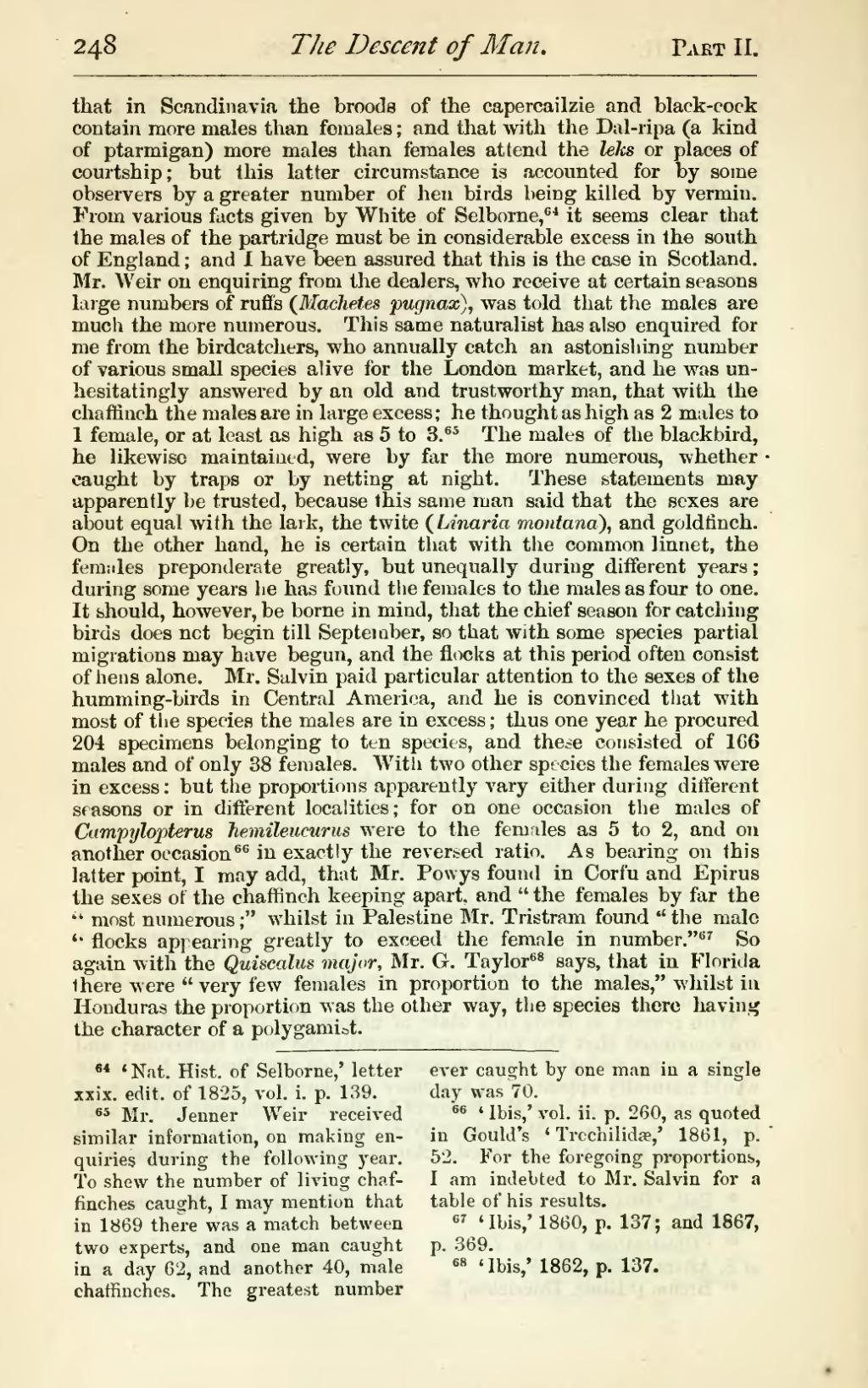that in Scandinavia the broods of the capercailzie and black-cock contain more males than females; and that with the Dal-ripa (a kind of ptarmigan) more males than females attend the leks or places of courtship; but this latter circumstance is accounted for by some observers by a greater number of hen birds being killed by vermin. From various facts given by White of Selborne,[1] it seems clear that the males of the partridge must be in considerable excess in the south of England; and I have been assured that this is the case in Scotland. Mr. Weir on enquiring from the dealers, who receive at certain seasons large numbers of ruffs (Machetes pugnax), was told that the males are much the more numerous. This same naturalist has also enquired for me from the birdcatchers, who annually catch an astonishing number of various small species alive for the London market, and he was unhesitatingly answered by an old and trustworthy man, that with the chaffinch the males are in large excess; he thought as high as 2 males to 1 female, or at least as high as 5 to 3.[2] The males of the blackbird, he likewise maintained, were by far the more numerous, whether caught by traps or by netting at night. These statements may apparently be trusted, because this same man said that the sexes are about equal with the lark, the twite (Linaria montana), and goldfinch. On the other hand, he is certain that with the common linnet, the females preponderate greatly, but unequally during different years; during some years he has found the females to the males as four to one. It should, however, be borne in mind, that the chief season for catching birds does not begin till September, so that with some species partial migrations may have begun, and the flocks at this period often consist of hens alone. Mr. Salvin paid particular attention to the sexes of the humming-birds in Central America, and he is convinced that with most of the species the males are in excess; thus one year he procured 204 specimens belonging to ten species, and these consisted of 166 males and of only 38 females. With two other species the females were in excess: but the proportions apparently vary either during different seasons or in different localities; for on one occasion the males of Campylopterus hemileucurus were to the females as 5 to 2, and on another occasion[3] in exactly the reversed ratio. As bearing on this latter point, I may add, that Mr. Powys found in Corfu and Epirus the sexes of the chaffinch keeping apart, and "the females by far the most numerous;" whilst in Palestine Mr. Tristram found "the male flocks appearing greatly to exceed the female in number."[4] So again with the Quiscalus major, Mr. G. Taylor says, that in Florida there were "very few females in proportion to the males,"[5] whilst in Honduras the proportion was the other way, the species there having the character of a polygamist.
- ↑ 'Nat. Hist. of Selborne,' letter xxix. ed. of 1825, vol. i. p. 139.
- ↑ Mr. Jenner Weir received similar information, on making enquiries during the following year. To shew the number of living chaffinches caught, I may mention that in 1869 there was a match between two experts, and one man caught in a day 62, and another 40, male chaffinches. The greatest number ever caught by one man in a single day was 70.
- ↑ 'Ibis,' vol. ii. p. 260, as quoted in Gould's 'Trochilidæ', 1861, p. 52. For the foregoing proportions, I am indebted to Mr. Salvin for a table of his results.
- ↑ 'Ibis,' 1860, p. 137; and 1867, p. 369.
- ↑ 'Ibis,' 1862, p. 137.
